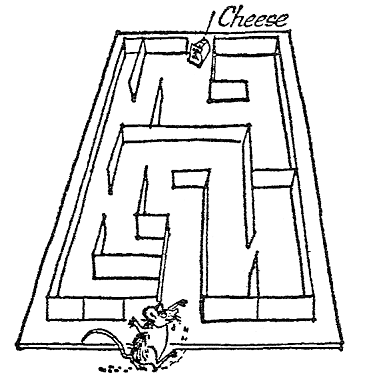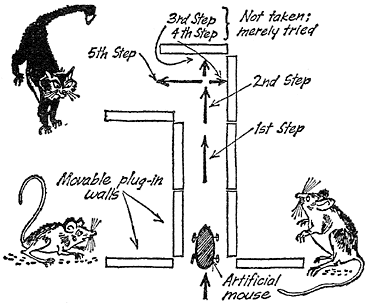The Mouse and the Cheese
An example of this is the artificial mouse we mentioned in the first chapter. Look at the maze in Illus. 44. It is almost as big as a table top. The inner walls are made of wood and can be moved about at will so that the design of the labyrinth can be changed. And now we place a mouse - first of all, a live one - in front of the entrance to the maze - and a piece of cheese at the exit.

Illus. 44
What happens? The mouse smells the cheese. He cannot see it. So he starts looking, always following his nose, for a way to get to it through the labyrinth. If he is a reasonably sensible and experienced mouse he will finally, after much scurrying back and forth, reach his cheese. If you make the experiment several times with the same animal, he will eventually learn the right way and speedily take the shortest route to the cheese without wasting time on detours.
If we move the inner walls around to form a labyrinth with a quite different pattern of paths, the wretched mouse will at first stop in his tracks, bothered and bewildered. In time he will pluck up courage and try out a new route, until after several repetitions he will again be able to find the way.
The scientific aspect of this procedure is that the mouse acquires experience in the maze and learns from his experience. But an average computer has approximately the same degree of learning power. That can be proved with our artificial mouse, which is actually a miniature model of a computer designed precisely so that it can find its way through a labyrinth. There is a certain element of sleight-of-hand at work, of course. The imitation mouse hustling through the maze is nothing more than a mouse-like piece of metal. The calculating head, the mouse's brain so to speak, is a small data processor underneath the table. Its pulses move a powerful magnet beneath the table top, and this magnet directs the visible robot rodent. Pegs at the bases of the movable wooden walls forming the paths inside the maze are plugged into wired sockets on its floor and thus give the computer an electronic image of the path layout in the maze.
And now the metal mouse is poised before the entrance to the labyrinth, waiting for you to switch on his intellect from underneath the table. When you have done so, a buzzing sound will indicate that the mouse's brain has started working. The first question it investigates is whether it is advisable to take a step forward. It seems that it is. The mouse advances, and storage cell 1 notes the pulse sequence "01." It is intended to mean "one step forward." Another step follows. It too was obviously the right one to take. Storage cell 2 also registers "01." The third step is also tried out by a move forward. But the mouse then finds itself up against a blank wall; no further progress, apparently, is possible in this direction. A sub-program comes into action, giving the instruction: "Try going to the right!"

Illus. 45
The artificial mouse tries to do so, making its fourth step. No through way. The sub-program says to it: "Try going to the left!"
So the fifth step the mouse takes is leftwards, which turns out to be correct Satisfied, storage cell 3 registers: "Move to the left, pulse sequence 11."
That is how the apparatus feels its way through the labyrinth. Now and then, our "rodent" will find itself in a blind alley. If it can neither continue nor turn to the right nor to the left, the sub-program dictates to it: "Try going back!" and the artificial mouse then creeps back until an opening appears either on the right or the left indicating the start of another path. In this case, there is of course a risk that the creature will now take the (correct) path by which it came, right back to the entrance. (Real mice sometimes do the same thing.) The danger can be avoided by means of a little sharp practice on the part of the program-maker. If the automatic mouse is instructed, for example, to move first to the left when making each step and not to continue on its way forwards until it has done so, then is told to try turning to the right (and, only if all three paths are of no avail, to turn round and go back) it will never by mistake run back along a path unless returning from a blind alley. Try this out for yourself some time with a pencil and a sheet of paper!
The artificial mouse needs only to stumble once through the labyrinth to find the right way. Once it arrives at the exit, the program blots out from the storages all the steps which led to blind alleys and made the mechanical mouse turn back What is left over is the speediest and shortest way from the entrance to the exit. The artificial mouse learns it much more quickly than the real one - and needs no cheese.
©
by PhiloPhax & Lauftext
& Redaktion Lohberg
Kybernetik
- Was ist das?
First printed in Germany: 1963